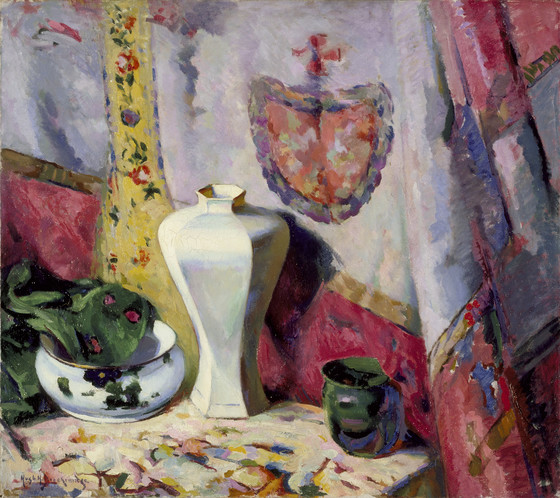In the 1910s Breckenridge painted and exhibited a large number of tabletop arrangements, usually including an assortment of fruit, vases, and pots....
In the 1910s Breckenridge painted and exhibited a large number of tabletop arrangements, usually including an assortment of fruit, vases, and pots. These still-life paintings became Breckenridge’s primary means of experiment. He wrote that still life was "the purest art of painting" for "it has no story to tell, other than that of line, form and color" (Valley House Gallery, unpublished book, p. 64 [Archiv. Am. Art microfilm roll 2410, fr. 266]). The Altar Cloth is typical of such experiments and is also characteristic of Breckenridge’s bolder style. Like many early American modernists, he was most influenced by Paul Cézanne (1839-1906) and Henri Matisse (1869-1954). He considered Cézanne to be the greatest artist of modern times, and the slightly tilted tabletop here recalls Cézanne’s still lifes. The painting is indebted to Matisse’s paintings of his fauve period for its brilliant color. Breckenridge did not hesitate to employ richly saturated hues of rose, emerald green, lavender, and ultramarine, even utilizing equally expressive colors in the shadows. The tall white vase in the center is framed by a green jar on the right and a white bowl and bright green cloth on the left. In typical postimpressionist fashion, Breckenridge placed the complementary color of the rose drape next to the green objects. Breckenridge often borrowed from Matisse the device of placing a painting or patterned hanging, here an altar cloth, behind the objects on the table to compromise the illusion of space by emphasizing surface pattern.
During the 1910s Breckenridge often worked closely with Arthur B. Carles (1880-1952), and the two even used the same objects in their still-life compositions. Both artists shared pictorial concerns and a debt to the fauve palette of Matisse. When The Altar Cloth is compared with Carles’s still-life paintings of this period an essential difference arises: no matter how bold Breckenridge is with his palette, he remains more conservative than Carles in his treatment of form. In The Altar Cloth Breckenridge did not completely relinquish traditional modeling and shading, while in his paintings Carles boldly flattened and simplified his objects. Breckenridge’s modernism at this stage of his development was allied to his use of nonreferential, expressionist color. Indeed, years later Carles acknowledged Breckenridge as the one who taught him about color resonance. It was the color of GEORGE INNESS that first attracted Breckenridge to painting in the 1880s, and color was always to dominate in his more avant-garde works.
The museum’s painting was frequently exhibited before William Preston Harrison saw it in Chicago and acquired it in 1923. While Harrison knew that artists with an impressionist slant, such as FREDERICK CARL FRIESEKE, disliked Breckenridge’s modernism, Harrison believed that Breckenridge was a fine painter with "a style all his own."
More...
